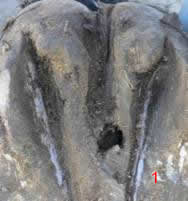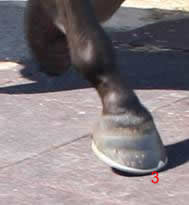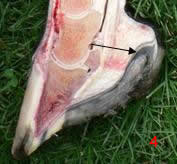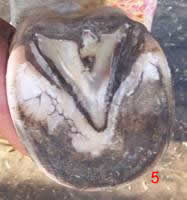Thrush is the invasion of frog tissue by opportunistic fungus and bacteria which thrive in moist, low oxygen environments.
It can occur in any horse, but is most often seen in those horses with narrow or contracted heels that also have a precipitous central sulcus, which is the ideal environment for thrush. Good healthy functional feet are less prone to thrush. Regular maintenance trimming is a great preventative for thrush along with a low sugar diet and regular and correct movement.
The presence of thrush is heralded by its unmistakably offensive odour. It firstly appears as a crumbly white cheesy substance when it invades surface tissue of the frog (Pic 2. below); but when it invades deeply into the lateral or central sulci, it mostly appears as a black paste. (Pic 1. below)
Horses are not usually lame when thrush invades, at least not until such time as it enters sensitive tissue (pic 4. below).
Thrush has the potential to cause very serious lameness - albeit indirectly - because it can set up incorrect mechanics. The pain from infected frogs causes a horse to impact on its toes (pic 3. below) which if sustained has a devastating effect on the navicular region of the foot (pic 6. below).
Any thrush invasion of the central sulcus should be treated very seriously.
Horses' feet should be routinely observed for the beginnings of thrush invasion. Horse owners should regularly use the hoof pick to inspect the central sulcus, checking for both sensitivity and also the presence of any foul smelling black paste.
The trimmer is the front line against thrush. Each and every time a hoof is trimmed, the frog should be checked for thrush and if any is present, any loose, overlying or diseased frog should be removed (pic 5.below)

Pic 1

Pic 2

Pic 3

Pic 4

Pic 5

Pic 6

Pic 7
There are many options available for topical treatment of thrush - the qualifier being that the agent needs to be strong enough to kill the bacteria, but at the same time benign enough to not adversely affect living tissue.
For stubborn cases of deep seated infection, nothing seems to be as effective as raw honey.
Whatever treatment you choose to control a thrush infection, it is imperative that daily treatment is applied until the disease is controlled and strong new healthy tissue has begun to regenerate.
Horses suffering from thrush invasion should be kept in a relatively dry environment wherever possible.
If a thrush infection persists, it is advisable to seek an experienced 'eye', to check for thrush's rare and more sinister cousin - equine canker (pic 7. above)